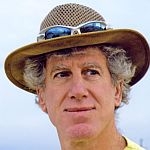 (Host) Commentator and naturalist Ted Levin has been working on a new
(Host) Commentator and naturalist Ted Levin has been working on a new
book about the intersection between timber rattlesnakes and their human
neighbors – leading to some interesting encounters.
(Levin) As a
kid in the late fifties, I saw a rattlesnake in the Staten Island Zoo
crawl out of its old skin and I was hooked. Although there used to be
timber rattlesnake colonies from Brooklyn to Sag Harbor by the end of
World War II the only rattlesnakes around my home in Long Island were
hanging as trophies in old farmhouses or submerged in jars of formalin
at the American Museum of Natural History. The last Long Island
Rattlesnake was killed near Islip in 1952, a little before my fourth
birthday.
My interest in timber rattlesnakes flickered for
decades but recently, it’s re ignited. For the past eighteen months,
I’ve been on the trail of rattlesnakes again, and last spring, I was
invited to join the Bashers, a quirky subculture of timber rattlesnake
biologists.
The Bashers have convened in New York State every
fall for the past five years, with an agenda full of informal lectures
and field trips. Two years ago, they counted rattlesnakes here in West
Haven. Their first gathering, called The Big Book Bash , was in
celebration of Jon Furman’s Timber Rattlesnakes in Vermont and New York .
They had so much fun they decided do it annually.
Bill Brown is
their driving force. He’s a retired Skidmore College biologist, who’s
researched rattlesnakes in the Adirondack foothills for more than thirty
years . An iconic scientist, Brown has achieved near rock-star status
in the world of herpetology. Much of what’s known about the timber
rattlesnake begins with his work. In fact, I haven’t read a journal
article on timber rattlesnakes that didn’t cite Brown at least five or
six times.
Bashers come from Vermont, Massachusetts,
Connecticut, New York, Kansas, Minnesota, West Virginia, and Ontario –
more or less outlining the historic northern range of the timber
rattlesnake. Some of them have collaborated with Brown for nearly forty
years, and to them, he’s a beer-drinking bud, the focus of good-natured
ribbing. At the gathering I attended, almost anything he said evoked a
wisecrack.
And he runs an entertaining ship. After pizza Friday
night, a jar of homemade grape jelly was given to the person who had
seen the first amphibian of the day: it was a leopard frog. Then, other
jars were awarded for the first snake sighting – it was a garter snake –
and for the first rattlesnake.
Saturday morning, breakfast
conversation touched on arcane points of milk snake taxonomy; the best
dates to implant a radio transmitter in a timber rattlesnake; and how an
esteemed, elderly Kansas herpetologist used a hamburger spatula to
catch copperheads. His wife forbade him from studying the larger timber
rattlesnake because his spatula handle was too short.
And
although six of the sixteen Bashers have been bitten by a timber
rattlesnake sometime during their careers – a few more than once – I
found it profoundly reassuring to realize that the fate of this rare and
reclusive reptile – rests largely in the Bashers’ capable hands.